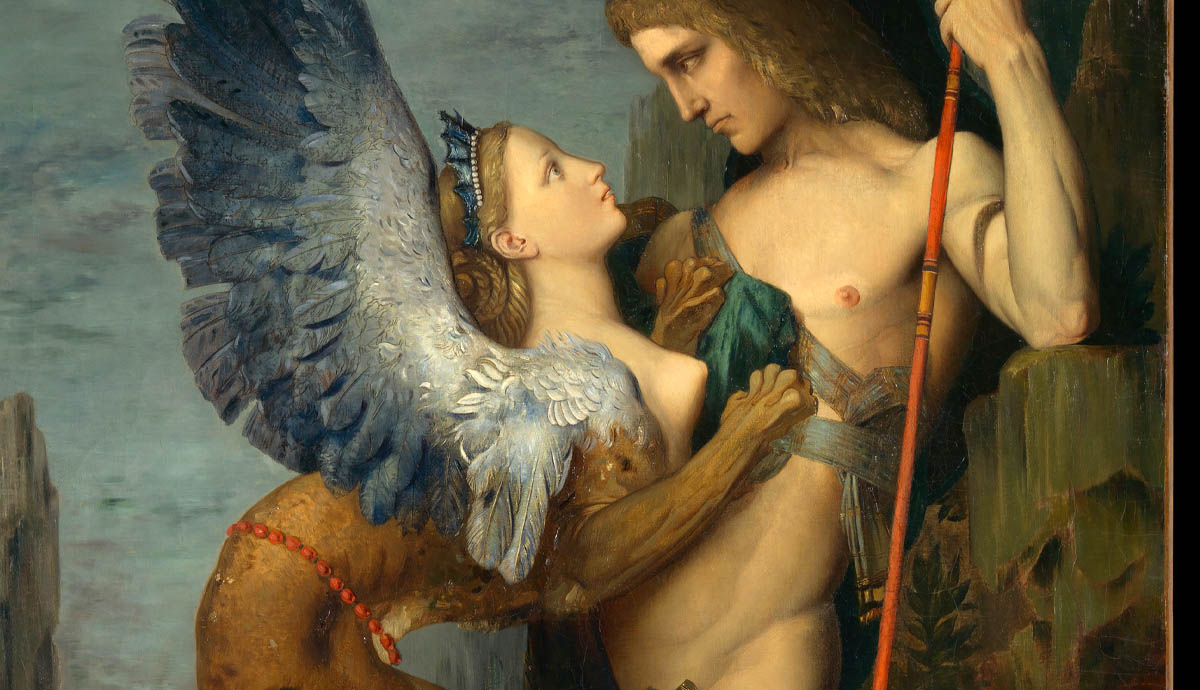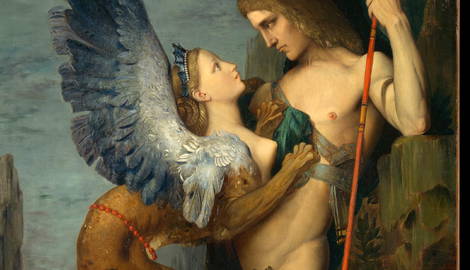
Oedipus Rex is a figure of Greek mythology from at least the 5th century B.C. Greek playwright Sophocles first introduced us to this character in his trilogy series known as the “Theban Plays,” which explore themes of fate, truth, and guilt. Oedipus Rex or Oedipus the King, is the first play in this trilogy of Athenian Tragedies, although the play opens part way into Oedipus’s story. Several ancient Greek poets, including Homer and Aeschylus, also mention his story in their works. The tale begins with King Laius and Queen Jocasta of Thebes.
Oedipus Rex The Infant

Unable to conceive a child, Laius went to Delphi to speak to the Oracle of Apollo. The Oracle told Laius that any son he produced was destined to kill him. When Jocasta bore a son, the future Oedipus Rex, Laius panicked. He pierced the baby’s ankles, riveted them together with a pin, and ordered his wife to kill her son. Jocasta could not bring herself to commit the murder and instead passed on the grisly duty.

She commanded a servant of the palace to kill the baby instead. Also unable to follow through with infanticide, the servant took him out to a mountain on the pretense of exposing him and leaving him there to die. In certain versions of the tale, the servant followed through on the command and left the infant hanging by his ankles from a tree. A mountain shepherd then found him there and cut him down, a moment that is depicted in several works of art. However, later in Sophocles’ Oedipus Rex, it is revealed that the servant passed the baby to a shepherd, who presented him to Polybus and Merope, the childless King and Queen of Corinth.

Adopted In Corinth
King Polybus and Queen Merope joyfully adopted the boy and raised him as their own. They gave him the name Oedipus as a reference to his swollen ankles. The medical term oedema, also written as edema, referring to swelling from fluid retention, derives from the same root as the name Oedipus. Polybus and Merope never told Oedipus of his origins. As a young man, he began to hear rumors that he was not their child. He went to consult the Oracle of Delphi, who told him he was destined to kill his father and marry his mother. Assuming this to mean his adopted parents, Oedipus immediately fled from Corinth, desperate to escape this fate.

On the road, Oedipus encountered an aristocratic old man in a chariot. He and the man began to argue as to whose chariot should have the right of way on the road. The argument turned violent, and the old man went to hit Oedipus with his scepter. But Oedipus blocked the blow and threw the man out of his chariot, killing him and subsequently fighting all of the old man’s retinue as well. A single slave witnessed the event and escaped. Then Oedipus continued on toward Thebes, but encountered a Sphinx who blocked the entrance to the city and devoured anyone who could not answer its riddle.
Oedipus The King

Though varying in some versions, the Sphinx’s riddle is most often reported as being, “what creature walks on four legs in the morning, two legs at noon, and three legs in the evening?” Oedipus thought for a moment and returned the correct answer: man, who crawls as a child, walks as an adult, and leans on a stick for support in old age. Having been defeated at its own game, the Sphinx threw itself from a cliff, reopening the way to Thebes. Upon entering the city, Oedipus learned that the king of Thebes had recently been killed, and Thebes was without a ruler. King Laius’s brother, Creon, had decreed that any man who could vanquish the Sphinx would be declared the new king.

Unbeknownst to Oedipus, the man with whom he had quarreled had been Laius, his birth father. Now the new king of Thebes, Oedipus Rex married the widowed Queen Jocasta, his own mother, fulfilling the oracle’s prophecy. Yet it would be years before the truth would reveal itself. Oedipus ruled Thebes successfully, and he and Jocasta produced four children, two sons and two daughters, Eteocles, Polynices, Antigone and Ismene. Many years later, when the children were already grown to young adulthood, a terrible plague fell upon Thebes, setting in motion the events of Sophocles’ Oedipus Rex.
Searching For Truth

By then the well-established and beloved king of Thebes, Oedipus was eager to do something to counteract the plague that was ravishing his city. He sent Creon, his brother-in-law, to consult the Oracle at Delphi. Creon relayed the Oracle’s declaration that the plague was due to the corruption and lack of justice in the murder of Laius, which remained unsolved. Verbally calling for a curse upon the murderer, Oedipus sprang into action and sought the advice of the blind prophet Tiresias. Yet Tiresias, knowing the terrible truth of the deed, initially refused to answer Oedipus. He advised him to forget the question for his own good. In a flurry of irritation, Oedipus all but accused Tiresias of involvement in the murder and Tiresias, enflamed, finally admitted the truth, telling Oedipus:
“Thou art the man, thou the accursed polluter of this land.”
Sole Witness

Still incensed and unable to face the truth of the prophet’s words, Oedipus refused to accept the answer, instead accusing Tiresias of plotting with Creon. “The trusty Creon, my familiar friend, hath lain in wait to oust me and suborned this mountebank, this juggling charlatan, this tricksy beggar-priest, for gain alone keen-eyed, but in his proper art stone-blind.” Tiresias shot back, “since thou hast not spared to twit me with my blindness–thou hast eyes, yet see’st not in what misery thou art fallen.” Finally Oedipus haughtily decreed that Tiresias must leave the city. Tiresias did so, with a final sarcastic quip reminding Oedipus that he had only come in the first place because Oedipus requested it.
Later, when Oedipus explained his distress to Jocasta, she attempted to reassure him by describing the site of Laius’s murder. Upon learning the location of the death and the appearance of Laius, Oedipus finally began to fear what Tiresias had already told him – that he was responsible for the death of the former king. Jocasta reassured him again. The only survivor, a slave now serving as a shepherd in the hills, told of multiple robbers, not just one. Oedipus resolved to speak with the man just the same, and sent word for him to come to the palace.
The Origins Of Oedipus

While waiting for the shepherd’s arrival, a messenger arrived at court to tell Oedipus that King Polybus was dead. He begged Oedipus to return to Corinth and take the throne of his father as the new king. Oedipus, however, still expressed reservations, as Merope remained living and he feared the fulfillment of the prophecy. Yet the messenger revealed another piece to the tale, reassuring Oedipus that it was the messenger himself who gave Oedipus to Polybus as a baby. Polybus and Merope were not his birth parents.
The chorus also added that the shepherd who brought baby Oedipus out from Thebes and gave him to this messenger was none other than the shepherd that Oedipus had summoned from the mountains to bear witness to Laius’s death. Beginning to suspect, Jocasta begged Oedipus to stop his relentless quest. Yet Oedipus stubbornly insisted on speaking with the shepherd. Panicked, Jocasta fled the scene.
Ensnared by Fate

Like Jocasta, the shepherd, when told that Oedipus is the child he refused to kill, realized the truth and desperately tried to avoid the question. However, Oedipus grew angry again, telling his soldiers to seize the shepherd and threatening him with torture and death if he didn’t answer. Terrified, the shepherd allowed Oedipus to pry the answers he sought.

Finally, the full truth emerged, that Oedipus had been the one to kill Laius, his true father, that his wife Jocasta was actually his mother, and their children his half-siblings. Horrified, Oedipus cried out, “Ah me! ah me! all brought to pass, all true! O light, may I behold thee nevermore! I stand a wretch, in birth, in wedlock cursed, a parricide, incestuously, triply cursed!” and rushed out.
From Oedipus Rex To Blind Beggar

A messenger hurried in to report that Jocasta had committed suicide, and Oedipus returned before the people and Creon, having blinded himself. He begged Creon, now the city’s guardian, to banish him from Thebes, and left the city that had been his kingdom as a blind beggar. The play Oedipus Rex ends with the final thought:
“Therefore wait to see life’s ending ere thou count one mortal blest; wait till free from pain and sorrow he has gained his final rest.”










